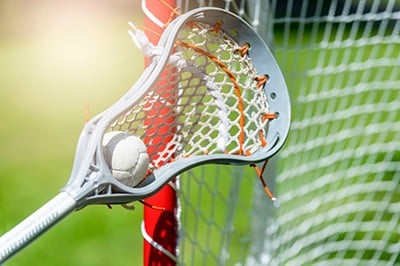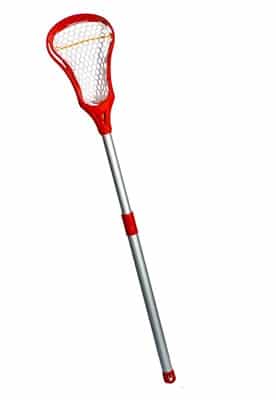Lacrosse is one of the oldest sports in North America, and its popularity continues to grow. But if you've ever wondered how are lacrosse sticks made, you're in for a treat!
From the materials used to assemble the shaft and lacrosse head to finally forming the pocket that holds the lacrosse ball — this is your guide on creating a lacrosse stick.
We'll dive into the process to explain how these specialized pieces of equipment come together.
More...
Take Away Key Points:
The Early History of a Lacrosse Stick

Lacrosse has a long and storied history, first appearing in 1000 A.D. when Native American tribes began playing the game with lacrosse sticks. Created partially from wood, the Algonquian tribe was the first to play in the St. Lawrence Valley.
On September 23, 1600, a significant innovation in lacrosse occurred when the first wooden lacrosse stick head was crafted for the game. This design featured an all-wood casing that surrounded the ball instead of just a leather covering, allowing it to stay in place more easily.
Lacrosse gained a major technological advantage in 1890 when Frank Lalley opened the first factory to mass-produce lacrosse sticks.
On July 20, 1937, Robert Pool revolutionized the game with his invention of the double-walled lacrosse stick, which made it harder for the ball to drop out and easier for players of all skill levels to join in.
The evolution of this stick continued until 1970, when modern-day materials and designs replaced it. The museum examples dating back to 1820 are some of the earliest artifacts related to this traditional game.
Count Paolo Andreani was traveling in the area that is now upstate New York when he wrote about a lacrosse stick in his journal, which he described as "a kind of racket, about 4 feet, 6 inches long, resembling the string of the bow".
In 1980, the first aluminum shaft was invented, featuring a slightly curved top that allowed the stick head to slide in more smoothly and fit any head.
Metal shafts followed this in 1990; these were thought to have better grip and reduce broken shafts.
Finally, in 1992 Warrior Lacrosse came out with titanium shafts that people preferred due to their greater durability than metal or wooden sticks and their secure grip, ensuring they wouldn't slip from your hands.
During the early 2000s, the lacrosse world experienced a shift as new varieties of heads were released.
This allowed players to customize and express themselves by choosing colors, pockets, and heads that fit their style. The introduction of these heads has been instrumental in increasing the overall popularity of lacrosse.
Traditional Lacrosse Sticks
Hickory wood is the base material used to create a single-piece lacrosse stick due to its hardiness and malleability.
The manufacturing process of traditional lacrosse sticks requires a trunk split into slivers about two inches wide, and one end is softened by steam before being bent over a post. These are then shaped using a steam bending process, with holes drilled into the top portion and sidewall of the head.
A wire may also be tied around it to maintain this shape as the wood dries and hardens again. The sidewall holes permit the weaving, which is then hardened by dipping them in resin.
Despite the popularity of plastic lacrosse sticks in current play, traditional lacrosse sticks, especially wooden ones, remain a viable option for box lacrosse goaltenders, senior and masters players, and women's field lacrosse players.
Such sticks are allowed under most regulations from the Canadian Lacrosse Association and NCAA, although the Western Lacrosse Association disallowed their use by non-goaltenders several years ago.
Modern Lacrosse Stick
The modern lacrosse sticks comprise two distinct parts: the head, in which nylon strings make a net, and the shaft.
The head is typically crafted from advanced plastic, offering greater flexibility on impact, reduced shock feelings, and easier groundballs for players.
Metal options such as aluminum, titanium, or scandium are also used for premium sticks though they come with their benefits (weight, strength, and durability). In addition, an octagonal shape to the shaft provides improved grip.
What Are Lacrosse Sticks Made of? (Lacrosse Stick Materials)

Lacrosse sticks have several components that require various materials to optimize their performance.
Ultimately, the type of material used in lacrosse stick manufacturing has a tremendous impact on the performance and feel of playing with it, so understanding what goes into making each component is key for any lacrosse player looking for an edge on the field.
1. Stick/Shaft materials
Most lacrosse shafts are made from aluminum, titanium, or scandium.
Lacrosse sticks come in many shapes and sizes, varying according to the player's strengths and preferences. Lighter shafts are usually more flexible and make moving easier, but they tend to wear out faster and be more expensive to replace.
Wooden shafts can also provide flex and are much cheaper; however, they are heavier, which may or may not be beneficial depending on how you want to improve your game.
2. Lacrosse head materials
If you were wondering what lacrosse heads are made of, most are constructed from nylon or plastic.
Lacrosse heads come in various shapes and sizes, depending on the player's position.
The scoop is at the top of the head, an important element for controlling groundballs.
Moving down the head, you'll find the sidewall, which has holes necessary for stringing up the stick and giving it its structure.
The thickness of the sidewall indicates what position it was designed for. Different companies create lacrosse heads tailored explicitly for various positions.
3. Lacrosse mesh
Finally, lacrosse mesh is often made of soft synthetic fibers such as nylon or cotton. Some stringing materials of lacrosse mesh even feature a combination of fiber types, providing extra grip while controlling the ball.
A mesh pocket is secured to the lacrosse head using four nylon strings: a top string, two sidewalls, and a bottom string. The top string is usually made from a sturdier material to withstand abrasive scooping forces.
The sidewalls are necessary for attaching individual mesh diamonds to the sidewall holes. They impact the pocket's performance by dictating its placement in the head, tightness of the channel, and depth.
The entire process of lacrosse stringing is like an art form. Mesh is the most common material used, as it is pre-made and requires less time to adjust than traditional stringing methods. However, different types of mesh are also available, offering a range of performance capabilities that match your style of play.
New stringers should start with mesh and progress to traditional if they wish, as the latter involves more complex tensioning and technique.
Women's Lacrosse Stick vs. Man's Lacrosse Stick
The mesh on the women's version usually has thick shooting strings called leathers and requires a tighter tie to create less of an actual pocket - pockets that would be illegal in the women's game.
This, combined with a shallower sidewall, makes it harder for players to handle the ball than men's lacrosse sticks. In addition, men's lacrosse sticks have done away with traditional stringing and use mesh netting to form pockets that allow easier ball handling when opponents check.
Compared to women's versions, men's lacrosse stick can come in more sizes – shorter lengths (40-42") are used by offensive players, while defenders and goalkeepers use longer ones (52-72").
The size of women's lacrosse sticks is fixed, ranging from 35.5-43.25", making it simpler to select.
FAQs
How is lacrosse mesh made?
Lacrosse mesh is made by weaving together synthetic strings. The strings are typically strong, flexible, and resistant to weathering, making them great for withstanding the wear and tear of competitive play.
The mesh is then knotted or sewn together to form the lacrosse stick pocket that allows players to catch, carry and throw the ball.
How are wooden lacrosse sticks made?
Wooden lacrosse sticks are made with various kinds of wood, including ash, hickory, and maple. The wood is cut and bent into the desired shape and then reinforced with fiberglass or metal rods for additional strength. Many lacrosse stick makers also customize the handles and add grip tape for extra comfort and improved performance.
What is the best material for a lacrosse shaft?

Scandium is the best material for a lacrosse shaft. This is a relatively new and rare material used to make lacrosse shafts. It is characterized by its lightweight, strength, and superior shock absorbency compared to other materials like aluminum or carbon fiber.
Scandium provides a higher performance level and improved balance despite being more expensive than aluminum.
Are lacrosse sticks made out of metal?
Yes, lacrosse sticks are typically made of metal, such as aluminum or carbon fiber. Both materials are lightweight, durable, and flexible enough to provide superior performance in handling and shooting.
Are wooden lacrosse sticks legal?
Yes, wooden lacrosse sticks are legal to play in certain regulations. While plastic and metal lacrosse sticks are preferred for their strength and durability, wooden ones have been used historically and can still be used in some competitions.
Do carbon lacrosse sticks break easily?
Carbon fiber lacrosse sticks are designed to be highly durable and lightweight.
While they are still vulnerable to wear and tear over time, the quality and the manufacturing process of carbon fiber materials make them unlikely to break easily in everyday play. Carbon fiber is also shock-absorbent, which can withstand more impact than traditional aluminum or wooden sticks.
Is a heavier lacrosse stick better?
Not necessarily. It all depends on the player's skill level and playing style. For example, heavier sticks tend to offer greater accuracy and power, but they can also be more difficult to maneuver.
On the other hand, lighter sticks give the player better control and mobility, which may be desired over power in some instances. Ultimately, the best stick weight for you will depend on your preferences and playing style.
What is the lightest lacrosse shaft material?
The lightest lacrosse shaft material is carbon fiber. Carbon fiber is a lightweight and extremely strong composite material that offers excellent shock absorption and durability.
What makes lacrosse stick expensive?
Several factors can determine the cost of a lacrosse stick. The quality of the materials used, the craftsmanship involved, and any special features it may have all contribute to the overall cost.
The sticks also feature custom grips and unique designs for enhanced comfort and performance. Finally, brand name sticks will typically cost more due to their reputation for quality and performance.
Conclusion
In conclusion, lacrosse sticks are crafted from various materials and come in many shapes and sizes. Each type is designed for a specific purpose and uses, making it important to select the right stick for your skill level and playing style.
Durability and craftsmanship play an important role in choosing the perfect stick, so consider these things when selecting. With this knowledge of how are lacrosse sticks made, you'll be well to find the ideal lacrosse stick for you!
